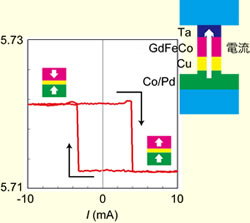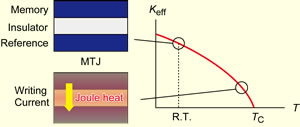Thermally assisted magnetization switching is a promising method to write information in the ultra high density magnetic random access memory without a significant increase of power consumption. Thermally assisted method will also be of benefit to use a material with high thermal stability without increasing the writing current for high density MRAM.
Our laboratory has been studying rare earth (RE) transition metal (TM) alloys and CoPd/Pd multilayers as a recording layer for the thermally assisted MRAM cell, since these exhibit large uniaxial anisotropy contributing a large thermal stability and have a suitable Curie temperature for the thermally assist writing. Figure shows spin transfer torque (STT) switching of GdFeCo memory layer fabricated using electron beam lithography. Positive and negarive currents switch the magnetization of GdFeCo up and down, respectively, via STT, which was confirmed by the change of the resistance of GdFeCo / Cu / [Co/Pd] multilayer. We also confirmed the temperature increase was effective to reduce STT switching current density (not shown here).
For the development of thermally assited MRAM, we have been studying the thermally assited switching of the hybrid memory layer with a low and high Curie temperature layers, and also the Joule heating in the insulator layer by flowing the writing current through magnetic tunnel junctions (MTJs).
|

STT switching of GdFeCo memory layer

Schematic of thermally assited STT switching (Perpendicular anisotropy Keff decreases with increasing temperature, which makes STT switching current low.)
IEEJ Trans. Fund. Mater., 140, 106 (2019). |
![]()


